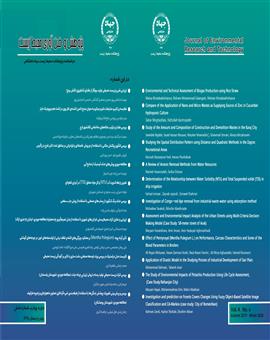مقایسه ی کاربرد ضایعات نانو و میکرو به عنوان منبع تامین کننده ی فلز روی در کشت هیدروپونیک خیار
محورهای موضوعی : آلودگی خاک و آب با فلزات سنگینسحر مقدسی بروجنی 1 , فتح اله کریم زاده 2
1 - صنعتی اصفهان
2 - صنعتی اصفهان
کلید واژه: Cucumis sativus, روی, نانوذرات لاستیک و هیدروپونیک,
چکیده مقاله :
دفع تایرهای فرسوده یکی از چالش های محیط زیستی سالهای اخیر بسیاری از کشورها است. پژوهش های پیشین نشان دادند خاکستر ضایعات لاستیک و نانوذرات آن منبع مناسبی از روی برای گیاه هستند. در پژوهش حاضر سعی بر آن شده تا ضمن امکان کاربرد ضایعات لاستیکی و نانوذرات آن (به عنوان منبع تامین کننده روی گیاه) و مقایسه آن با کود سولفات روی تجاری موجود در بازار امکانسنجی استفاده از نانوذرات در گیاه مورد بحث و بررسی قرار گیرد. به این منظور ضمن تولید نانوذرات و مشخصه یابی آن با میکروسکوپ الکترونی روبشی و عبوری، این ضایعات در کشت هیدروپونیک خیار به کار گرفته شده و عملکرد کمی و کیفی محصولات تغذیه شده با نانوذرات تولیدی، ذرات میکرونی لاستیک و نیز کود سولفات روی تجاری موجود در بازار مقایسه گردید. براساس نتایج بدست آمده با کوچک شدن اندازه ذرات لاستیک از میکرون به نانو درصد روی قابل عصاره گیری از 1.5 به 2.5 درصد افزایش یافت. نتایج این پژوهش نشان داد استفاده از نانوذرات لاستیک سبب افزایش عملکرد گیاه ضمن افزایش غلظت روی گیاه در مقایسه با کود سولفات روی تجاری موجود در بازار و نیز تیمار شاهد میگردند.
In recent years, disposal of waste tires is an environmental challenge in many countries. Previous researches has been shown that rubber waste ash and its nanoparticles can be used as an effective source of zinc (Zn) for plant. In this research, feasibility of using nanoparticles and rubber waste (as zinc supplying source in plant) is studied moreover comparing the nanoparticles of rubber waste with commercial zinc sulfate fertilizer available in the market. In this regard, moreover nanoparticles production and characterization them by scanning and transient electron microscope, these wastes were used in cucumber hydroponic culture, then the quantitative and qualitative performance of the fed products were compared with the commercial zinc sulfate fertilizer available in the market. According to the obtained results, by reducing the particle size of the rubber from micron to nano, Zn extractable percentage increased from 1.5 to 2.5%. So, using rubber nanoparticles increased plant performance and also, increased Zn concentration in plant tissues compared with commercial zinc sulfate fertilizer and those grown in control.
خوشگفتار¬منش، ا. ح. و آ. سنایی استوار، 1388. قابلیت استفاده روی موجود در ضایعات صنعتی پلیمری شده برای ذرت در یک خاک آهکی، علوم و فنون کشاورزی و منابع طبیعی، سال سیزدهم، جلد 50، شماره 91-103.
حمزه¬پور، ن.، م. ملکوتی و ع. مجیدی، 1389. برهمکنش عناصر روی، آهن و منگنز در اندام¬های مختلف گندم، مجله پژوهش¬های خاک، جلد 24، شماره 1-8.
Chaney, R. L., 2007. Effect of ground rubber vs. ZnSO4 on spinach accumulation of Cd from Cd-mineralized California soil. Abstract, WEFTECH Residuals Conference, Denver, CO, April
Taheri, S., Khoshgoftarmanesh A. H., Shariatmadari, H., 2011. Kinetics of zinc release from ground tire rubber and rubberash in a calcareous soil as alternatives to Zn fertilizers. Plant Soil. Vol. 341,pp. 89–97
Afyuni, M., Khoshgoftarmanesh, A. H., Dorostkar, V., Moshiri, R., 2007. Zinc and cadmium content in fertilizers commonly used in Iran. International Conference of Zinc Crops, Istanbul, Turkey, pp. 24-28
Carpita, N., Sabularse, D., Montezinos, D., Delmer, D. P., 1979 Determination of the pore size of cell walls of living plant cells. Science Vol .205,pp.1144–1147
Remya, N., Saino, H. V., Baiju, G., Maekawa, T., Yoshida, Y., Sakthi Kumar, D., 2010. Nanoparticulate material delivery to plant, Plant science. Vol.179, pp. 154-163
Lin, D. H., Xing, B. S., 2007. Phytotoxicity of nanoparticles. inhibition of seed germination and root elongation. Environmental Pollution. Vol.150, pp. 243–250
Lin, D., Xing, B., 2008. Root uptake and phytotoxicity of ZnO nanoparticles. Environmental Science And Technology. Vol.42, pp. 5580-5585
Zhang, L., Su, M., Liu, C., Chen, L., Huang, H., Wu, X., Liu, X., Yang, F., Gao, F., Hong., F., 2007. Antioxidant Stress is Promoted by Nano-anatase in Spinach Chloroplasts Under UV-B Radiation.. Biology Trace Element Research. Vol.109, pp.68
Torney, F., Trewyn, G. B., Lin V. S. Y., Wang, K., 2007. Mesoporous silica Nanoparticles Deliver DNA and Chemicals into Plants. Nanotechnology. Vol.2, pp. 295-300
Moghaddasi, S., Khoshgoftarmanesh, A.H., Karimzadeh, F., Chaney, R. L., 2013. Preparation of nano-particles from waste tire rubber and evaluation of their effectiveness as zinc source for cucumber in nutrient solution culture. Scientia Horticulturae, vol.160, pp.398–403
Taheri, S., Khoshgoftarmanesh, A. H., Shariatmadari, H., 2011. Kinetics of zinc release from ground tire rubber and rubberash in a calcareous soil as alternatives to Zn fertilizers. Plant and Soil. Vol.341, pp.89–97
Jhson, C. M., Stout, P. R., Broyer, T. C., Carlton, A. B., 1957. Comparative chlorine requirements of different plant species. Plant and Soil. Vol.8, pp.337-353
Lindzay, W. L., Norvell, W. A., 1978. Development of DTPA test for zinc, iron, manganese and copper. Soil Science. vol.42, pp.421-428.
Kinoshita, T., Yamaguchi, K., Akita, S., Niib, S., Kawaizumi F., Takashi, K., 2005. Hydrometallurgical recovery of zinc from ashes of automobile tire wastes. Chemosphere. Vol.59, pp.1105-1111.
Schauble, C., 1999. Frit Industries. U.S. EPA. February 24, page 1
Epstein, E., 1999. Silicon. Ann Reu. Plant physiol., Plant Mole. Biology. 50: 641-644
Liang, Y. C., Q. Shen, Z. Shen and T. Ma. 2008. Effects of silicon on salinity tolerance of two barley cultivars. Biol ogy Science. Vol.19, pp. 173-183.
Alloway, B. J., 2008. Zinc in Soil and Crop Nutrition. Online book published by the International Zinc Association, Brussels, Belgium and Paris, France
Marschner, H., 1995. Mineral Nutrition of Higher Plants, 2nd ed., Academic Press, London


